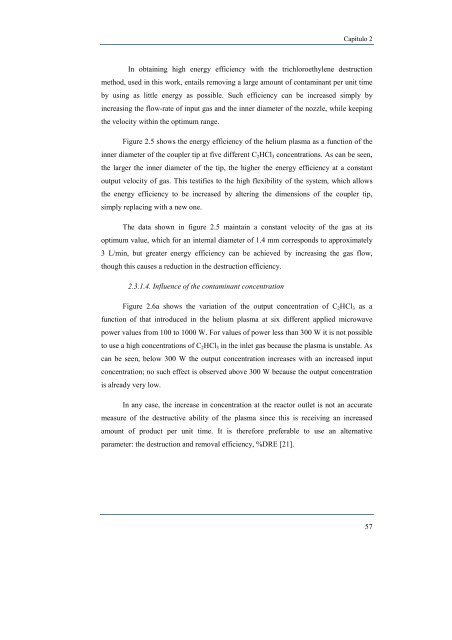estudio y caracterización de un plasma de microondas a presión ...
estudio y caracterización de un plasma de microondas a presión ...
estudio y caracterización de un plasma de microondas a presión ...
Create successful ePaper yourself
Turn your PDF publications into a flip-book with our unique Google optimized e-Paper software.
Capítulo 2<br />
In obtaining high energy efficiency with the trichloroethylene <strong>de</strong>struction<br />
method, used in this work, entails removing a large amo<strong>un</strong>t of contaminant per <strong>un</strong>it time<br />
by using as little energy as possible. Such efficiency can be increased simply by<br />
increasing the flow-rate of input gas and the inner diameter of the nozzle, while keeping<br />
the velocity within the optimum range.<br />
Figure 2.5 shows the energy efficiency of the helium <strong>plasma</strong> as a f<strong>un</strong>ction of the<br />
inner diameter of the coupler tip at five different C2HCl3 concentrations. As can be seen,<br />
the larger the inner diameter of the tip, the higher the energy efficiency at a constant<br />
output velocity of gas. This testifies to the high flexibility of the system, which allows<br />
the energy efficiency to be increased by altering the dimensions of the coupler tip,<br />
simply replacing with a new one.<br />
The data shown in figure 2.5 maintain a constant velocity of the gas at its<br />
optimum value, which for an internal diameter of 1.4 mm corresponds to approximately<br />
3 L/min, but greater energy efficiency can be achieved by increasing the gas flow,<br />
though this causes a reduction in the <strong>de</strong>struction efficiency.<br />
2.3.1.4. Influence of the contaminant concentration<br />
Figure 2.6a shows the variation of the output concentration of C2HCl3 as a<br />
f<strong>un</strong>ction of that introduced in the helium <strong>plasma</strong> at six different applied microwave<br />
power values from 100 to 1000 W. For values of power less than 300 W it is not possible<br />
to use a high concentrations of C2HCl3 in the inlet gas because the <strong>plasma</strong> is <strong>un</strong>stable. As<br />
can be seen, below 300 W the output concentration increases with an increased input<br />
concentration; no such effect is observed above 300 W because the output concentration<br />
is already very low.<br />
In any case, the increase in concentration at the reactor outlet is not an accurate<br />
measure of the <strong>de</strong>structive ability of the <strong>plasma</strong> since this is receiving an increased<br />
amo<strong>un</strong>t of product per <strong>un</strong>it time. It is therefore preferable to use an alternative<br />
parameter: the <strong>de</strong>struction and removal efficiency, %DRE [21].<br />
57

















